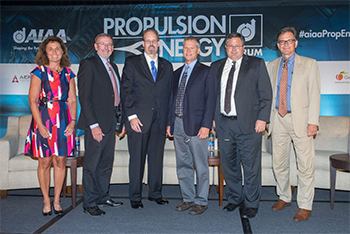Getting Humans to Mars Dependent on Public-Private Collaboration, Merging Technologies Written 12 July 2017
Panelists: Moderator Julie Van Kleeck, vice president of advanced space and launch programs and strategy, Aerojet Rocketdyne; Darby Cooper, senior manager for integrated analysis, Space Launch System, Exploration Launch Systems, Boeing; Steve Jolly, chief engineer for commercial civil space, Lockheed Martin; Jerrol Littles, director of advanced launch vehicle propulsion, Aerojet Rocketdyne; David H. Manzella, solar-electric propulsion project chief engineer, NASA’s Glenn Research Center; Todd May, director, NASA’s Marshall Space Flight Center
By Lawrence Garrett, AIAA Web Editor

To develop the propulsion technologies needed for a manned mission to Mars or other human deep space exploration, merging technologies and collaboration between government, private industry and academia are paramount, a panel of experts said July 12 at the 2017 AIAA Propulsion and Energy Forum in Atlanta.
Panelists in the “Space Exploration Propulsion” session agreed the key technologies that will help enable a mission to Mars are solar-electric propulsion and advancements in chemical propulsion, such as nuclear thermal propulsion.
“Whether it’s electric or some form of chemical propulsion, we think all are necessary,” said Steve Jolly, chief engineer for commercial civil space at Lockheed Martin.
Jolly said Lockheed considers solar-electric propulsion a “key enabler.”
Darby Cooper, senior manager for integrated analysis of the Space Launch System at Boeing, said that even though solar-electric propulsion has been in operation in space for decades, stakeholders now need “to scale it up in size and power to accomplish these human missions.”
Cooper cited NextSTEP, which aims to advance the needed technologies for a functioning cislunar outpost, as one example and said work is also underway to design a deep space transport, a larger transfer vehicle “essentially rated for interplanetary travel.” He noted that such a vehicle will require the efficiencies of a solar-electric propulsion system able to move large masses but also that possesses “a propellant ratio that will be effective.”
“This technology also enables on-ramping of nuclear thermal propulsion, when that technology is mature,” Cooper said.
David H. Manzella, solar-electric propulsion project chief engineer at the NASA’s Glenn Research Center, also stressed the importance of government and industry working together to advance solar-electric propulsion technology and called the investment in solar-array technology “critical.”
Joe Cassady, executive director for space programs at Aerojet Rocketdyne, explained nothing is done without power and that there’s important work being done in that area. For example, he said, NASA is funding the development of larger solar-array mechanisms in order to generate more power.
“This is critical work,” Cassady said, adding that right now the chosen technology is “solar-electric, because that’s the technology that works.”
Todd May, director of NASA’s Marshall Space Flight Center, cautioned that the challenges for a manned Mars mission are much greater than those that had to be overcome to get a man on the moon and that new technologies are going to have to be developed.
“There are solutions out there today that we don’t know,” he said, noting that nuclear thermal propulsion is one possible solution. “I think the solution for nuclear thermal propulsion lies in the ability to make a reactor using low-enriched uranium.”
May explained that he thinks that method could reduce some of the activation energy and thus “get that development over the hump and actually get the solution that, from a physics perspective, is a very good solution.”
May also said additive manufacturing will be key and could significantly reduce many of the manufacturing costs that will be associated with deep space exploration.
“I really do think we’ve got a pretty good feel for how we’re going to get to cislunar space,” May said. “But if we’re going to go beyond that, these solutions need to start coming together.”
